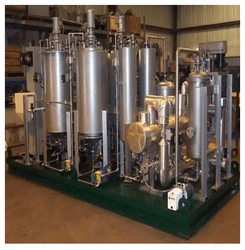Sulfation Leaching Treatment ilmenite Concentrate Titanium Slags
The United States depends upon imports to supply most of the rutile and up to 70 pct of the ilmenite and titanium slag requirements for the manufacture of TiO2 pigments, titanium metal, and welding rod coatings. To help assure an adequate supply of titanium raw materials to meet national economic and strategic needs, the Bureau […]
How to Produce Pure Lead from Galena Concentrates
A major cost factor in the sintering and smelting process for producing Pb is the control needed to meet existing environmental standards for Pb emissions. Another issue is the current concern over acid rain, which will in all probability result in even more stringent controls on emission of S gases. The method consists of (1) […]
Ceramic Corrosion Resistance to Sulfuric Acid
Extensive literature, published during recent years, identifies three general methods of fine-particle preparation: (1) solution techniques, (2) vapor-phase techniques, and (3) salt decomposition techniques. Solution techniques, also referred to as “chemical” preparation, offer the advantages of ease of preparation, good control of composition, and homogeneity. Among the solution techniques a number of terms, such as […]
How to Precipitate Mercury from Gold Silver Cyanide Leach
The discovery of low-grade gold-silver deposits in the United States has resulted in construction of several cyanide-leach carbon-in-pulp (CIP) milling facilities. Gold and/or silver ores typically contain other metals such as mercury and a variety of base metals. Of all the metals most likely present, mercury presents the most serious problem. Typically, 10 to 30 […]
Solvent Extraction & Electrowinning Operating Costs

It is fairly easy to separate the capital cost for SX from that for EW. For this reason one might choose to categorize the operating costs in the same way. However, because of the way SX-EW plants are designed and operated and the manner in which costs are allocated this can be a difficult task. […]
Gold Recovery from Molybdenum Concentrate by Cyanidation
Here we describe a cyanide leaching-carbon adsorption plant designed to recover the gold from the molybdenum concentrate. Process Design: The molybdenum concentrate assays typically, 45 percent molybdenum, less than 1 percent copper (chalcopyrite) and 3.5-5.0 percent iron (chalcopyrite-pyrite). Gold and silver average 8 and 40 ppm respectively which at an average molybdenum concentrate production of 10 […]
How Does Heap Leaching Agglomeration Work
Agglomeration means that the clays and fine particles contained in the ore adhere to the coarser particles and create a coating of fines around the coarse particles. When the ore has few fines and the percolation problems are not severe, the addition of a liquid may be all that is necessary to render the fines […]
Why Convert a CCD Gold Circuit to CIL- Pro & Cons
Is a CCD gold circuit better than a CIL or CIP plant? Why convert? Any good reasons? The Cortez staff was responsible for conceptual design, equipment procurement and equipment installation, construction management and supervision for the mill conversion project. Structural design and engineering for the building additions were provided, and the construction labor for the […]
Recover Silver & Gallium with Acidified Thiourea Solutions
The recovery of silver and gallium from flue dust with acidified thiourea solutions was examined. The studied parameters were temperature, particle size, thiourea concentration, acid concentration, and the presence of oxidants. The study of the extraction of these two metals was undertaken in sulfuric acid medium. Silver dissolution was dependent on all examined parameters, whereas […]
Copper Bioleach using Thiobacillus and Nutrient Additions
A new bacterium, Thiobacillus cuprinus, can extract copper from chalcopyrite as rapidly as T. ferrooxidans. On solution with and without nutrient amendments and bacterial growth media were supplemented with T. ferrooxidans or T. cuprinus in shake flask studies. Both species extracted -42% of the copper using growth media. In one case, T. cuprinus solubilized approximately […]
